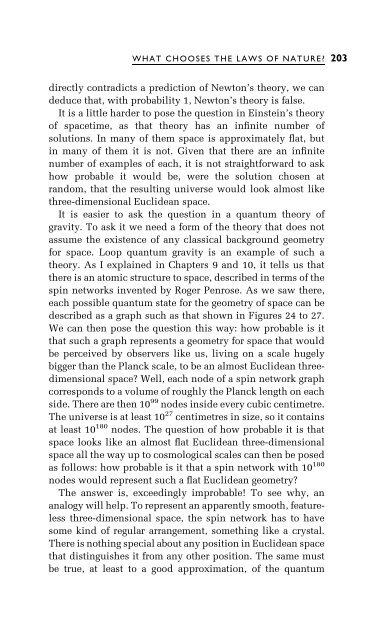Three Roads To Quantum Gravity
Three Roads To Quantum Gravity
Three Roads To Quantum Gravity
You also want an ePaper? Increase the reach of your titles
YUMPU automatically turns print PDFs into web optimized ePapers that Google loves.
WHAT CHOOSES THE LAWS OF NATURE?<br />
203<br />
directly contradicts a prediction of Newton's theory, we can<br />
deduce that, with probability 1, Newton's theory is false.<br />
It is a little harder to pose the question in Einstein's theory<br />
of spacetime, as that theory has an in®nite number of<br />
solutions. In many of them space is approximately ¯at, but<br />
in many of them it is not. Given that there are an in®nite<br />
number of examples of each, it is not straightforward to ask<br />
how probable it would be, were the solution chosen at<br />
random, that the resulting universe would look almost like<br />
three-dimensional Euclidean space.<br />
It is easier to ask the question in a quantum theory of<br />
gravity. <strong>To</strong> ask it we need a form of the theory that does not<br />
assume the existence of any classical background geometry<br />
for space. Loop quantum gravity is an example of such a<br />
theory. As I explained in Chapters 9 and 10, it tells us that<br />
there is an atomic structure to space, described in terms of the<br />
spin networks invented by Roger Penrose. As we saw there,<br />
each possible quantum state for the geometry of space can be<br />
described as a graph such as that shown in Figures 24 to 27.<br />
We can then pose the question this way: how probable is it<br />
that such a graph represents a geometry for space that would<br />
be perceived by observers like us, living on a scale hugely<br />
bigger than the Planck scale, to be an almost Euclidean threedimensional<br />
space? Well, each node of a spin network graph<br />
corresponds to a volume of roughly the Planck length on each<br />
side. There are then 10 99 nodes inside every cubic centimetre.<br />
The universe is at least 10 27 centimetres in size, so it contains<br />
at least 10 180 nodes. The question of how probable it is that<br />
space looks like an almost ¯at Euclidean three-dimensional<br />
space all the way up to cosmological scales can then be posed<br />
as follows: how probable is it that a spin network with 10 180<br />
nodes would represent such a ¯at Euclidean geometry?<br />
The answer is, exceedingly improbable! <strong>To</strong> see why, an<br />
analogy will help. <strong>To</strong> represent an apparently smooth, featureless<br />
three-dimensional space, the spin network has to have<br />
some kind of regular arrangement, something like a crystal.<br />
There is nothing special about any position in Euclidean space<br />
that distinguishes it from any other position. The same must<br />
be true, at least to a good approximation, of the quantum



![arXiv:1001.0993v1 [hep-ph] 6 Jan 2010](https://img.yumpu.com/51282177/1/190x245/arxiv10010993v1-hep-ph-6-jan-2010.jpg?quality=85)


![arXiv:1008.3907v2 [astro-ph.CO] 1 Nov 2011](https://img.yumpu.com/48909562/1/190x245/arxiv10083907v2-astro-phco-1-nov-2011.jpg?quality=85)








![arXiv:1002.4928v1 [gr-qc] 26 Feb 2010](https://img.yumpu.com/41209516/1/190x245/arxiv10024928v1-gr-qc-26-feb-2010.jpg?quality=85)
![arXiv:1206.2653v1 [astro-ph.CO] 12 Jun 2012](https://img.yumpu.com/39510078/1/190x245/arxiv12062653v1-astro-phco-12-jun-2012.jpg?quality=85)
